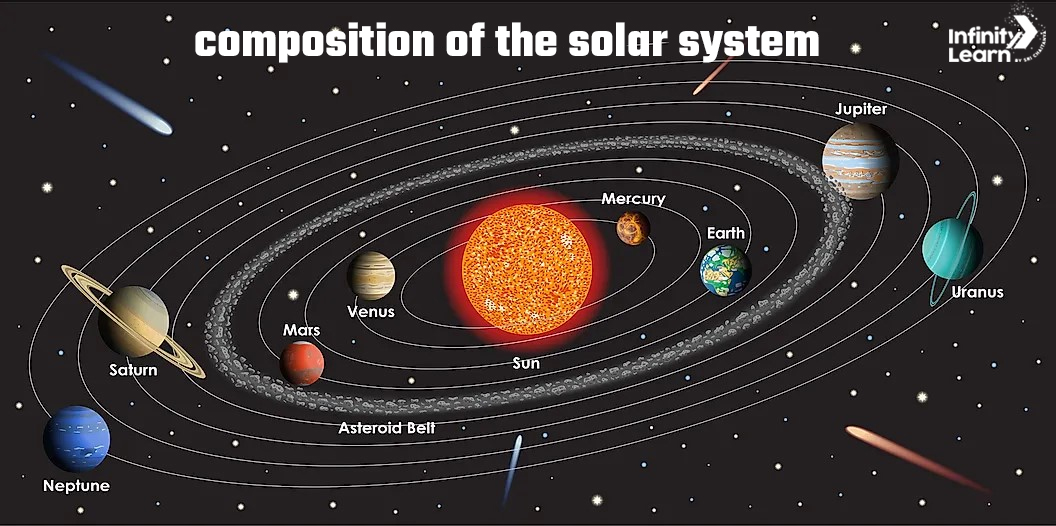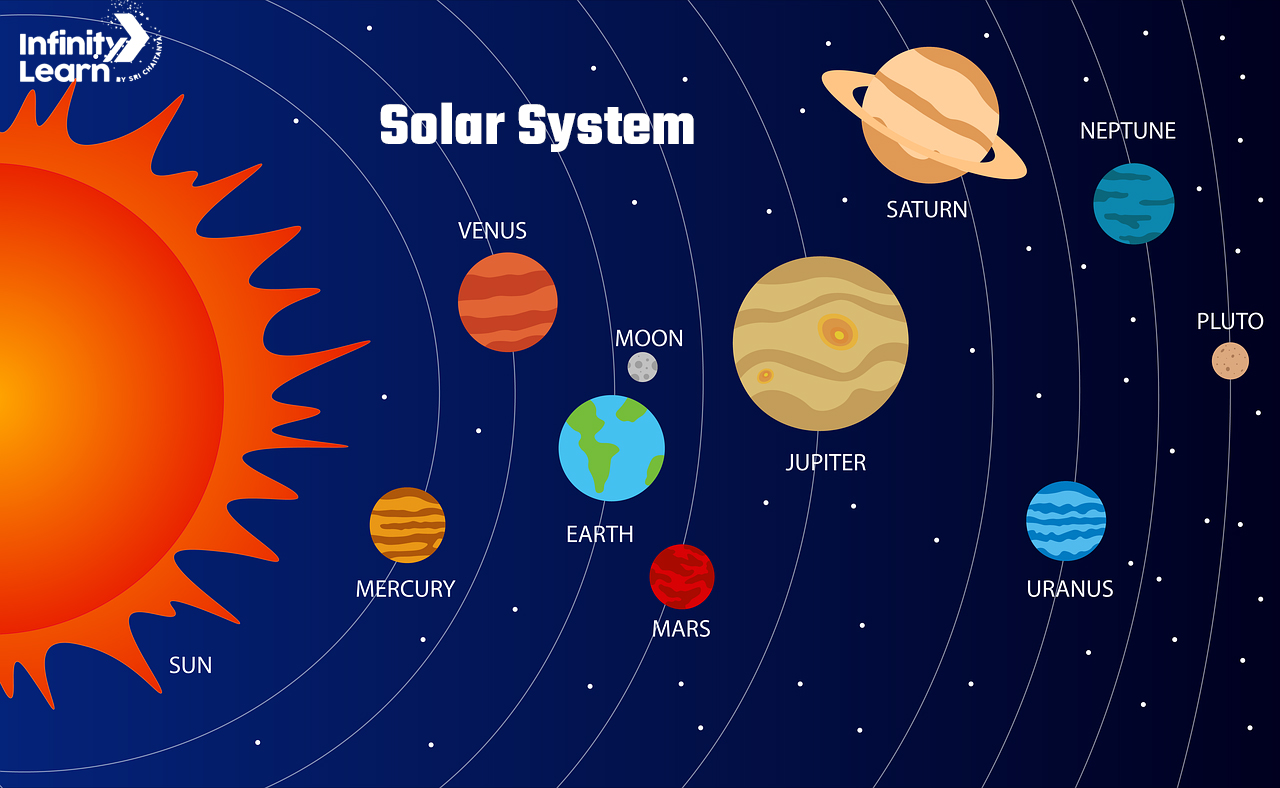Table of Contents
The solar system includes one star, eight planets, five dwarf planets, at least 290 moons, over 1.3 million asteroids, and around 3,900 comets. It is located in the Orion Arm of the Milky Way galaxy. Our solar system moves around the galaxy’s center at about 515,000 miles per hour (828,000 kilometers per hour) and takes about 230 million years to make one full orbit.
We call it the solar system because it consists of our star, the Sun, and everything held by its gravity. This includes the planets Mercury, Venus, Earth, Mars, Jupiter, Saturn, Uranus, and Neptune; the dwarf planets Pluto, Ceres, Makemake, Haumea, and Eris; as well as hundreds of moons and millions of asteroids, comets, and meteoroids.4o.
Also Check: More Science Topics for Kids
Composition of the Solar System
The Sun, located at the center of the solar system, controls the movement of other bodies with its gravity and holds over 99 percent of the system’s mass. The planets, listed from closest to farthest from the Sun, are Mercury, Venus, Earth, Mars, Jupiter, Saturn, Uranus, and Neptune. Four of these planets—Jupiter, Saturn, Uranus, and Neptune—have ring systems.

All planets except Mercury and Venus have one or more moons.Pluto was considered a planet after its discovery in 1930 beyond Neptune. However, in 1992, an icy object was found even farther from the Sun than Pluto. More such objects were discovered, including one named Eris, which is about the same size as Pluto. It became clear that Pluto was just one of many large objects in this new group, known as the Kuiper belt. In August 2006, the International Astronomical Union (IAU) decided to reclassify Pluto as a dwarf planet. For more on this decision and the IAU’s definition of a planet, see the term “planet.”Any natural solar system object that is not the Sun, a planet, a dwarf planet, or a moon is called a small body.
This group includes asteroids, meteoroids, and comets. Most of the hundreds of thousands of asteroids, or minor planets, orbit between Mars and Jupiter in the asteroid belt. The many fragments of asteroids and other small pieces of solid matter, smaller than a few tens of meters across, in space are called meteoroids.4o
Solar System Drawing Image / Solar System Chart

Solar System Project for Kids
Earth is our home and the only place where life can exist. It is part of the vast universe, which contains all the stars and planets. The solar system is a group of objects that are held together by gravity and orbit around the Sun.
The solar system has the Sun at the center, which is the closest star to Earth. The Sun is a star. There are eight planets in the solar system: Mercury, Venus, Earth, Mars, Jupiter, Saturn, Uranus, and Neptune. Each planet has unique features. Besides the Sun and planets, the solar system also has asteroids, moons, and orbits. It is important to learn about these planets and the Sun, which make up the solar system.
Creating a model of the solar system is a common school science project. In this article, we will discuss how to design and build a solar system project for school. This article will guide you through making a solar system in five easy steps.
Size of the Sun and Planets in Increasing Order
Mercury
Diameter: 4,880 km
Description: Mercury is the smallest planet in our Solar System and is closest to the Sun. It has no moons and a surface marked by craters.
Mars
Diameter: 6,779 km
Description: Known as the Red Planet, Mars is the second smallest planet. It has two moons, Phobos and Deimos, and is famous for its reddish appearance due to iron oxide on its surface.
Venus
Diameter: 12,104 km
Description: Venus is similar in size to Earth but has a thick, toxic atmosphere. It’s the hottest planet in our Solar System due to its runaway greenhouse effect.
Earth
Diameter: 12,742 km
Description: Our home planet is the largest of the terrestrial planets. Earth is unique for its liquid water and life-sustaining atmosphere.
Neptune
Diameter: 49,244 km
Description: Neptune is the smallest of the gas giants but still much larger than the terrestrial planets. It’s known for its deep blue color and strong winds.
Uranus
Diameter: 50,724 km
Description: Uranus is a gas giant with a blue-green color due to methane in its atmosphere. It rotates on its side, making it unique among the planets.
Saturn
Diameter: 116,460 km
Description: Famous for its stunning ring system, Saturn is the second-largest planet. It’s a gas giant primarily composed of hydrogen and helium.
Jupiter
Diameter: 139,820 km
Description: Jupiter is the largest planet in our Solar System, with a mass more than twice that of all the other planets combined. It’s known for its Great Red Spot and numerous moons.
The Sun
Diameter: 1,391,000 km
Description: The Sun is by far the largest object in our Solar System. It’s a massive star at the center of our Solar System, providing the light and energy necessary for life on Earth.
Colour Of The Planets
Earth – White, Brown, Green, and Blue
Jupiter – Orange, White cloud stripes, Brown and Tan
Mercury – Grey
Venus – Grey and Brown
Uranus – Blue-green
Mars – Red, tan and brown
Neptune – Blue
Saturn – Blue-grey, Golden and brown
Material Required for Solar System
- Cardboard sheet of standard length or based on the area you want.
- Paint in black and the colors of the planets mentioned above.
- Foam balls in four different sizes, matching the sizes of the planets mentioned above.
- Make a ring for Saturn from the cardboard sheet. The ring should fit the foam ball for Saturn
Steps
Step 1: Paint the cardboard black and let it dry. Make sure the paint is even. Also, paint the foam balls according to the size and color of each planet.
Step 2: Draw orbits around the Sun in the center of the cardboard. Paint the orbits white. Leave a bigger gap between the orbits of Mars and Jupiter for the asteroid belt.
Step 3: Add a ring around Saturn and place the painted foam balls (planets) as shown in the picture.
Step 4: Glue all the planets, including the Sun, onto the cardboard.
Step 5: Between Mars and Jupiter, stick small pieces of white paper randomly to represent the asteroid belt.
Hottest Planet in the Solar System
Venus is the hottest planet in our solar system. The temperature on its surface is around 465°C!
Coldest Planet in Solar System
The coldest planet is actually Uranus, not Neptune, even though Uranus is a billion miles closer to the Sun. Uranus has recorded the lowest temperature in the Solar System at -224℃.
Smallest Planet in Solar System
Mercury is the tiniest planet in our solar system. It is just over one-third the size of Earth, with a diameter of about 3,032 miles (4,880 kilometers) at the equator. Mercury is the closest planet to the Sun, with an average distance of 36 million miles (58 million kilometers).4o
Biggest Satellite in Solar System
Discovered by Galileo in 1610, Ganymede is one of Jupiter’s moons. With a diameter of about 5,260 kilometers, it is larger than the planet Mercury.
What is Off Grid Solar System
An off-grid solar system includes batteries and a backup. It produces electricity even when there’s no power or at night. It consists of four main parts: solar panels, an inverter, batteries, and a system balancer.
Solar Power Irrigation System
Solar-powered irrigation systems (SPIS) are a eco-friendly way to water crops. They work by using solar energy to pump water instead of using fossil fuels. This helps cut down on greenhouse gas emissions from farming.
Solar System FAQ’s
Is Mercury hotter than Venus?
No, Venus is hotter than Mercury.
Which is the coldest planet?
Neptune is the coldest planet in our solar system.
What is Earth's twin planet?
Venus is often called Earth's twin planet.
Where is the tallest mountain in our solar system?
The tallest mountain in our solar system is on Mars, called Olympus Mons.
Which is the hottest planet in our solar system?
Venus is the hottest planet in our solar system.
Which is the biggest planet in the solar system?
Jupiter is the biggest planet in our solar system.
Which is the largest planet in our solar system?
Jupiter is also the largest planet in our solar system.
What is solar power irrigation system?
It's a system that uses solar energy to pump water for irrigation.
Is solar irrigation good?
Yes, solar irrigation is good because it's sustainable and reduces reliance on fossil fuels.
What is a solar powered water system?
It's a system that uses solar energy to pump, purify, or heat water for various purposes.
What is a solar lighting system?
It's a lighting system that uses solar energy to power lights, usually through solar panels and batteries.
How does a solar light work?
Solar lights have panels that absorb sunlight, which is then converted into electricity to power the lights.
What are the benefits of solar powered lighting?
Solar powered lighting is environmentally friendly, cost-effective, and doesn't require an electrical grid connection.









